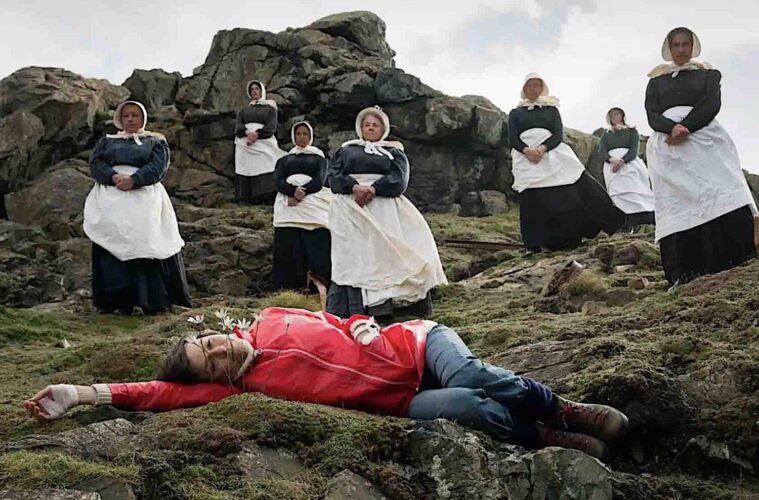 The latest Little Movie That Could — and it’d be hard to shrink any smaller — Mark Jenkin’s Cornish folk-horror chestnut Enys Men, is something of a miniature masterpiece of mood, texture, and elliptical frisson. That is, in fact, all it is: If you’re in dire need of other things, like complex plotting or witty dialogue, or even genuine genre thrills, seek elsewhere. Jenkin’s film would feel like a throwback if in fact there ever were an era in which such compact, spare, elusive films were routinely made by feverish hermits on deserted islands, in Cornwall, no less. You absolutely get the sense of visiting a private obsession — that the movie was made by an unfashionably fixated loner in the middle of an uncivilized nowhere, who answered to nobody but the sea and the wind.
The latest Little Movie That Could — and it’d be hard to shrink any smaller — Mark Jenkin’s Cornish folk-horror chestnut Enys Men, is something of a miniature masterpiece of mood, texture, and elliptical frisson. That is, in fact, all it is: If you’re in dire need of other things, like complex plotting or witty dialogue, or even genuine genre thrills, seek elsewhere. Jenkin’s film would feel like a throwback if in fact there ever were an era in which such compact, spare, elusive films were routinely made by feverish hermits on deserted islands, in Cornwall, no less. You absolutely get the sense of visiting a private obsession — that the movie was made by an unfashionably fixated loner in the middle of an uncivilized nowhere, who answered to nobody but the sea and the wind.
Enys Men — Cornish for “stone island,” which is where we spend the whole movie — is the latest in Jenkin’s decades-long, underseen exploration of Cornish working-class landscape and peoples. (His last feature, 2019’s Bait, immediately established him in contemporary Brit film culture as an authentic new voice, though he’d been crafting indigenous shorts and features since 2002.) It’s an odd breakout film — a horror movie absent of scares, a psychological dream film light on character, a nearly wordless mood piece about the malingering ghosts of history. If you’ve been Hoovered in by the trailer, you have a sense of what’s on offer: Jenkin’s offbeat, super-intimate, entirely analog visual strategy, without very much concern for narrative cargo.
Mary Woodvine, a weathered Brit character stalwart who’s been a favorite of Jenkin’s, stars as a nameless woman on an uninhabited coastal island, working as a “volunteer” (according to the credits) monitoring soil temperatures and keeping a log. It’s 1973, and her existence consists entirely of trudging the island’s rocky terrain, checking on an anomalous sprig of cliffside flowers, dropping stones down an abandoned mineshaft, struggling with her beaten-up generator, and, at night, reading A Blueprint for Survival, a real 1972 paperback penned by a horde of environmental scientists advocating for the radical decentralization of modern society. Her ham radio buzzes and grumbles mysteriously. The film’s rhythms are regular but abrupt — Jenkin will smash cut between a landscape and a mega-close-up of Woodvine’s weary eyes without warning. The unforgiving sea and sky are not scenery so much as threatening conditions.
Soon the woman’s subjective world invades the landscape — we glimpse a teen girl standing on the roof, a priest huddled in the night shadows, a small crowd of schoolgirls in white, a gruff visiting sailor, a gang of reproachful miners staring out at us from the darkness. They’re all either ghosts or memories, we reason, and it may be Jenkin’s cinematic point that it hardly matters one way or the other. In many ways, ghosts and memories are the same thing, taking on the same role, as inflictions of the past upon the present.
Eventually, the flowers Woodvine’s stoic heroine attends to begin growing lichens — and then so does she, the growth appearing to sprout from an old, long scar across her belly, which we can only take as an oblique sign of her enmeshing with the wilderness, if anything. (Lichens are not a sign of decay, but of stubborn natural resourcefulness.) Jenkin summons the current jones for British folk horror in gestures and fleeting images, suggesting the inexorable power of the earth to retain and vomit up past traumas. But he’s not interested in story, only in grit, grain, and mouthfeel. Shooting on old-fashioned 16mm celluloid, and sometimes scuffing his stock up to suggest a lost reel from the ’70s, Jenkin musters memories of moody precedents like Nicolas Roeg’s Don’t Look Now (1973), and even Brit TV folkloric series such as Children of the Stones (1976). Yet Enys Men is so abstracted and so committed to the natural elements that it comes closer to the experimental landscape films of James Benning, but with megaliths and an elusive backstory of tragedy and grief. It’s not the only recent film that proves that far less is indisputably much more — which is becoming a fecund indie subgenre — but it’s surely the most granular.
Read more reviews by Michael Atkinson here.
Editor’s note: The disclaimer below refers to advertising posts and does not apply to this or any other editorial stories. LA Weekly editorial does not and will not sell content.
Advertising disclosure: We may receive compensation for some of the links in our stories. Thank you for supporting LA Weekly and our advertisers.

